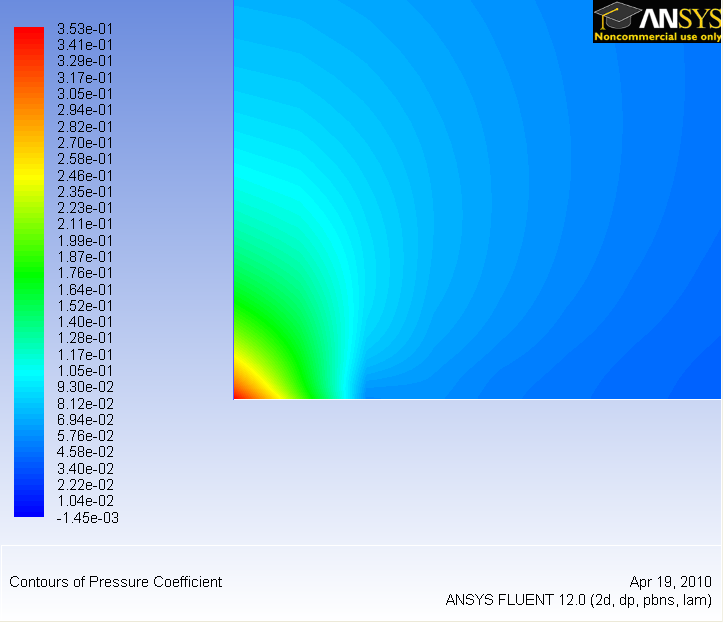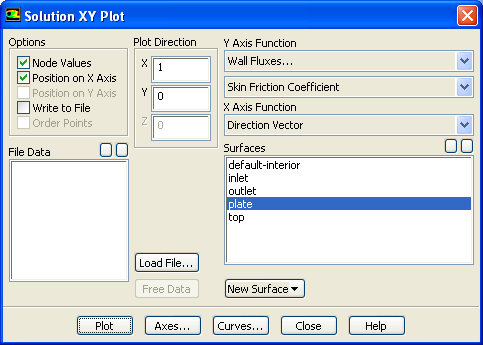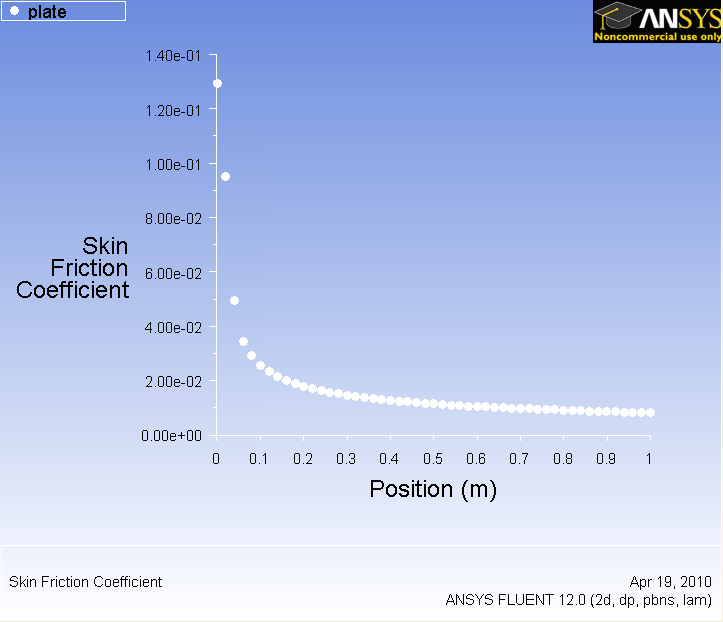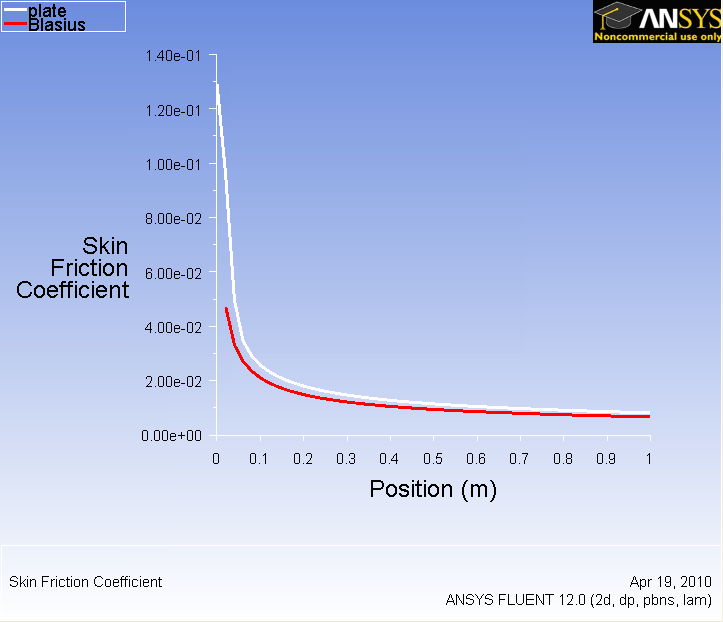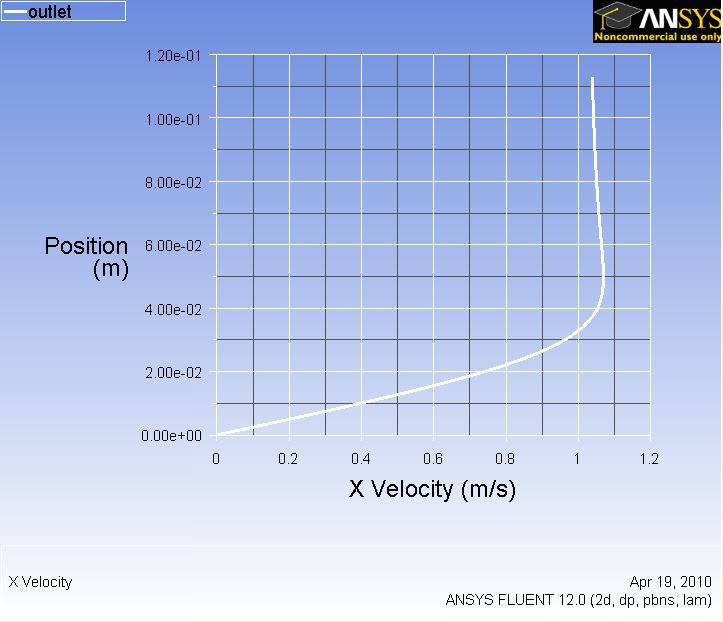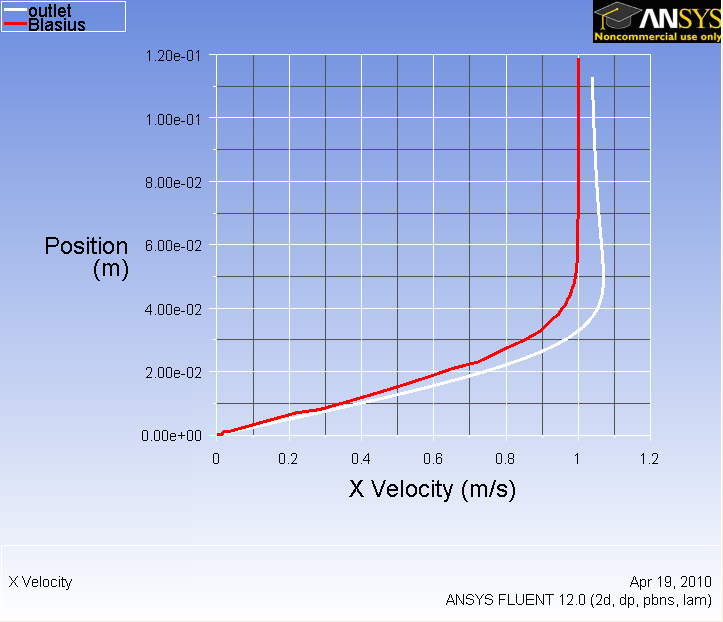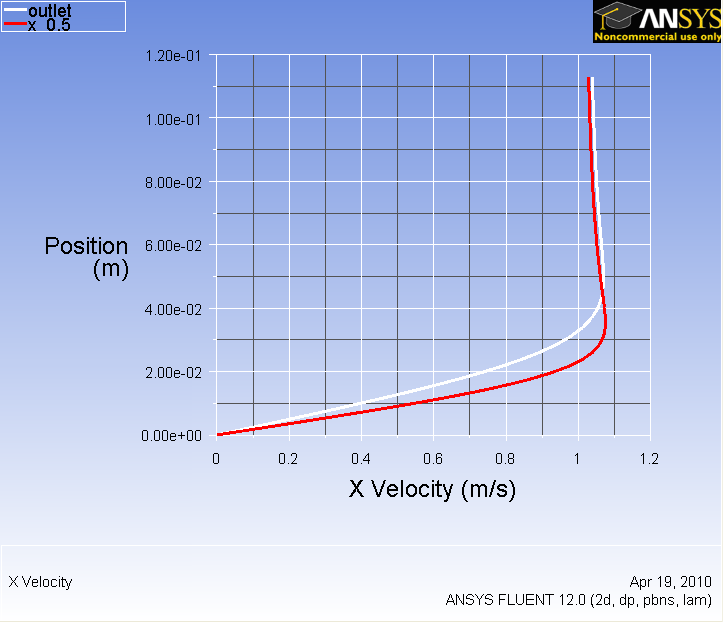| Wiki Markup |
|---|
h1. FLUENT - Flat Plate Boundary Layer Step 6 |
...
| Panel | ||
|---|---|---|
{panel} Author: Rajesh Bhaskaran, CornellUniversityProblem Specification 1. University [Problem Specification|FLUENT - Flat Plate Boundary Layer Problem Specification] [1. Pre-Analysis & Start-up |FLUENT - Flat Plate Boundary Layer Step 1] [2.Geometry Geometry|FLUENT - Flat Plate Boundary Layer Step 2] [3.Mesh Mesh|FLUENT - Flat Plate Boundary Layer Step 3] [4. Setup (Physics) |FLUENT - Flat Plate Boundary Layer Step 4 *New] [5.Solution 6. Results 7. Verification & Validation | ||
| Info | ||
| ||
Click here for the FLUENT Solution|FLUENT - Flat Plate Boundary Layer Step 5 *New] {color:#ff0000}{*}6. Results{*}{color} [7. Verification & Validation|FLUENT - Flat Plate Boundary Layer Step 7] {panel} {info:title=Useful Information} [Click here|SIMULATION:FLUENT - Flat Plate Boundary Layer Step 6] for the FLUENT 6.3.26 version. |
...
{info} h2. Step 6: |
...
Plot Velocity Vectors
Results h4. {color:#cc0000}Plot Velocity Vectors{color} Let's plot the velocity vectors obtained from the FLUENT solution. |
...
*Results > Graphics and Animations > Graphics > Vectors |
...
* Zoom in a little using the middle mouse button to peer more closely at the velocity vectors |
...
Remember to save the image using
Main Menu > File > Save picture
You can then select coloring, resolution and format for your picture. Then click on Save and give a name to the file to save it.
Plot Pressure Coefficients
Now we will display the pressure coefficient contour but first we need to set the reference values for velocity. Go back to:
Problem Setup > Reference Values
And select inlet under Compute From. Then go back to:
Results > Graphics and Animations > Graphics > Contours
Select Pressure...under Contours Of. Then select Pressure Coefficient from the second drop-down menu. Also, check the Filled checkbox and set Levels to 90. Then click on Display to update the display window.
...
Zoom in at the leading edge.
Why is the pressure not constant at the leading edge of the plate?
Plot Skin Friction Coefficient
Now we will plot the skin friction coefficient along the flat plate.
Results > Plots > XY Plot
Change Pressure to Wall Fluxes. Then, change Wall Shear Stress to Skin Friction Coefficient. Under Surfaces, select plate.
Click Plot.
Higher Resolution Image
Now, compare your solution to the with the Blasius solution's skin friction by loading the file and then plotting it with your solution. (Download file here)
...
Plot Velocity Profiles
Results > Plots > XY Plot
Uncheck Position on X Axis and check Position on Y Axis under Options. Under Plot Direction, set X to 0 and Y to 1. Under X Axis Function, select Velocity...Then, change Velocity Magnitude to X Velocity. Finally under surface, select outlet. Before we are ready to plot, click on the Axes... button and rescale the y-axis from 0 to 0.12. Also, check the Major Rules and Minor Rules for both axes. Remember that you must click the Apply button when performing changes in each axis.
Click Plot.
Higher Image Resolution
To compare with the Blasius solution, download the solution here. Click Load File...and select the file you just downloaded. Then plot the solutions again to display both lines on the same graph.
What is the noticeably different between two solutions? Why is the velocity overshoot 1 for FLUENT's solution?
Now we will compare the velocity profile at two sections. Create another section in the middle of the plate.
Again, in the XY Plot window under New Surface > Line/Rake
...
. \\ !step6_1.png|width=298,height=255! [Higher Resolution Image|^step6_1.png] {new window: Higher Resolution Image} ^step6_1.png{new window} \\ Remember to save the image using *Main Menu > File > Save picture* You can then select coloring, resolution and format for your picture. Then click on {color:#990099}{*}{_}Save{_}{*}{color} and give a name to the file to save it. h4. {color:#cc0000}Plot Pressure Coefficients{color} Now we will display the pressure coefficient contour but first we need to set the reference values for velocity. Go back to: *Problem Setup > Reference Values* And select {color:#990099}{*}{_}inlet{_}{*}{color} under {color:#990099}{*}{_}Compute From._{*}{color} Then go back to: *Results > Graphics and Animations > Graphics > Contours* Select {color:#990099}{*}{_}Pressure..._{*}{color}under {color:#990099}{*}{_}Contours Of{_}{*}{color}. Then select {color:#990099}{*}{_}Pressure Coefficient{_}{*}{color} from the second drop-down menu. Also, check the {color:#990099}{*}{_}Filled{_}{*}{color} checkbox and set {color:#990099}{*}{_}Levels{_}{*}{color} to 90. Then click on {color:#990099}{*}{_}Display{_}{*}{color} to update the display window. \\ !step6_002.png|width=298,height=255! [Higher Resolution Image|^step6_002.png] \\ Zoom in at the leading edge. !step6_003.png|width=298,height=255! [Higher Resolution Image|^step6_003.png] \\ Why is the pressure not constant at the leading edge of the plate? h4. {color:#cc0000}Plot Skin Friction Coefficient{color} Now we will plot the skin friction coefficient along the flat plate. *Results > Plots > XY Plot* Change {color:#990099}{*}{_}Pressure{_}{*}{color} to {color:#990099}{*}{_}Wall Fluxes{_}{*}{color}. Then, change {color:#990099}{*}{_}Wall Shear Stress{_}{*}{color} to {color:#990099}{*}{_}Skin Friction Coefficient{_}{*}{color}. Under {color:#990099}{*}{_}Surfaces{_}{*}{color}, select {color:#990099}{*}{_}plate{_}{*}{color}. !step6_004.png|width=334,height=238! Click {color:#990099}{*}{_}Plot{_}{*}{color}. !step6_005.png|width=297,height=255! [Higher Resolution Image|^step6_005.png]\\ Now, compare your solution to the with the Blasius solution's skin friction by loading the file and then plotting it with your solution. ([Download file here|^cf_blasius_Re1e4.xy]) \\ !step6_006.png|width=302,height=173! Also, you can change the symbol into lines by going to {color:#990099}{*}{_}Curves..._{*}{color} and click on the corresponding pattern that you like. Increase the {color:#990099}{*}{_}Weight{_}{*}{color} to 3 for readability. Both results should be fairly similar. !step6_007.png|width=298,height=255! [Higher Resolution Image|^step6_007.png] \\ h4. {color:#cc0000}Plot Velocity Profiles{color} *Results > Plots > XY Plot* Uncheck {color:#990099}{*}{_}Position on X Axis{_}{*}{color} and check {color:#990099}{*}{_}Position on Y Axis{_}{*}{color} under Options. Under {color:#990099}{*}{_}Plot Direction{_}{*}{color}, set X to 0 and Y to 1. Under {color:#990099}{*}{_}X Axis Function{_}{*}{color}, select {color:#990099}{*}{_}Velocity..._{*}{color}Then, change {color:#990099}{*}{_}Velocity Magnitude{_}{*}{color} to {color:#990099}{*}{_}X Velocity{_}{*}{color}. Finally under {color:#990099}{*}{_}surface{_}{*}{color}, select {color:#990099}{*}{_}outlet{_}{*}{color}. Before we are ready to plot, click on the {color:#990099}{*}{_}Axes..._{*}{color} button and rescale the y-axis from 0 to 0.12. Also, check the {color:#990099}{*}{_}Major Rules{_}{*}{color} and {color:#990099}{*}{_}Minor Rules{_}{*}{color} for both axes. Remember that you must click the {color:#990099}{*}{_}Apply{_}{*}{color} button when performing changes in each axis. Click {color:#990099}{*}{_}Plot{_}{*}{color}. !step6_008.png|width=298,height=255! [Higher Image Resolution|^step6_008.png] \\ To compare with the Blasius solution, download the solution here. Click {color:#990099}{*}{_}Load File..._{*}{color}and select the file you just downloaded. Then plot the solutions again to display both lines on the same graph. !step6_009.png|width=298,height=255! [Higher Resolution Image|^step6_009.png] \\ What is the noticeably different between two solutions? Why is the velocity overshoot 1 for FLUENT's solution? Now we will compare the velocity profile at two sections. Create another section in the middle of the plate. h4. Again, in the XY Plot window under *New Surface > Line/Rake* Check the {color:#990099}{*}{_}line tool{_}{*}{color} checkbox under Options and set the initial coordinate to _(0.5,0)_ and final coordinate to _(0.5,0.5)_. Under the {color:#990099}{*}{_}New Surface Name{_}{*}{color} field, type in *x_0.5* and then click the {color:#990099}{*}{_}Create{_}{*}{color} button to create the line. |
...
We can now plot and compare the velocity profile at the mid point and the outlet of the flow. |
...
Under {color:#990099}{*}{_}Surfaces{_}{*}{color}, select {color:#990099}{*}{_}outlet{_}{*}{color} and {color:#990099}{*}{_}x_0.5{_}{*}{color} and {color:#990099}{*}{_}Plot |
...
...
{_}{*}{color}.
!step6_010.png|width=298,height=255!
[Higher Resolution Image|^step6_010.png]
\\
Go to [Step 7: Refine Mesh|FLUENT - Flat Plate Boundary Layer Step 7] |
 Sign-up for free online course on ANSYS simulations!
Sign-up for free online course on ANSYS simulations!